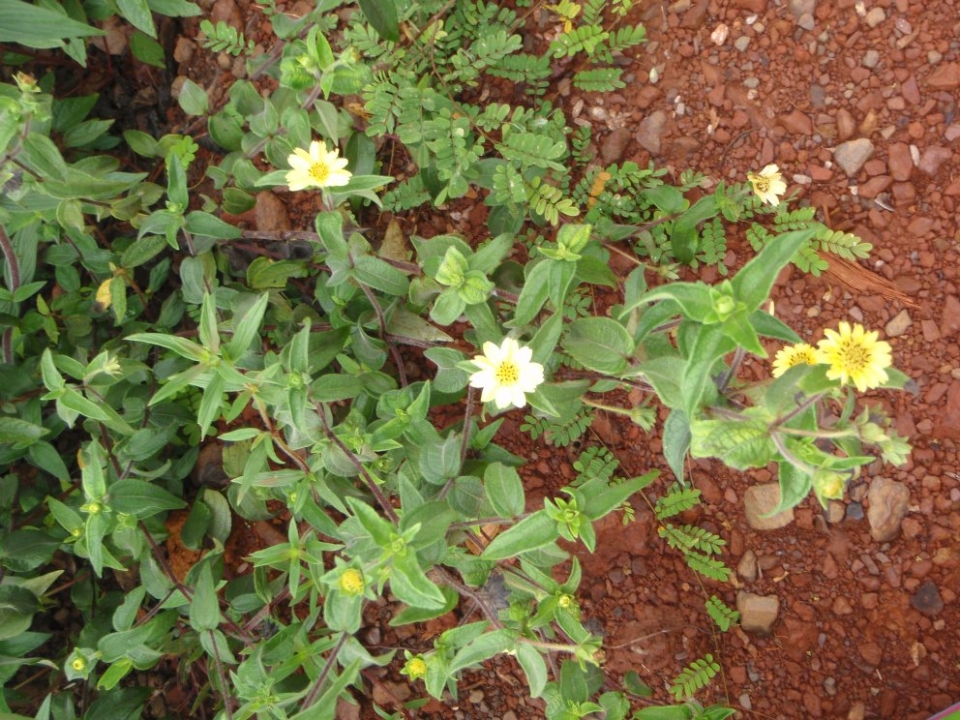Aspilia africana

|
|
Aspilia africana Common Names: Haemorrhage Plant, Wild Sunflower, Bush
Marigold Species ID: NMP-011 | wfo-0000122653 | NCBI:txid194251 Scientific
Classification Kingdom: Plantae Phylum: Tracheophyta Class: Magnoliopsida Order: Asterales Family: Asteraceae Genus: Aspilia Species: A. africana Synonyms: Aspilia guineensis (O.Hoffm.) Wild, Aspilia latifolia (Oliv. & Hiern) S.F.Blake, Wedelia africana (P.Beauv.) Hepper Morphological Description Aspilia africana, commonly known as the Haemorrhage Plant or Wild Sunflower, is a
perennial herbaceous plant, typically growing 0.6–2 m tall, occasionally up to
3 m in fertile soils. Its key features include: · Stem: Erect, semi-woody at the base, quadrangular, covered with
bristly hairs · Leaves: Opposite, lanceolate to ovate, 5–15 cm long, 2–7 cm wide,
rough with bristly hairs, serrated margins · Flowers: Bright yellow, daisy-like, 3–5 cm in diameter, in terminal
or axillary heads, with slender ray florets · Fruit: Achene, 3–5 mm long, quadrangular, with a pappus of short
bristles Distribution and Habitat Aspilia africana is native to tropical and subtropical Africa, spanning from
Senegal and Gambia in West Africa to Ethiopia and Sudan in the east, and south
to Angola, Zambia, and South Africa. It thrives in: · Ecosystems: Forest margins, savannas, grasslands, disturbed areas,
roadsides, and farmlands · Climate: Tropical to subtropical, with rainfall of 500–2,000 mm
annually and temperatures of 20–35°C · Soils: Well-drained, sandy to loamy, often nutrient-rich, tolerating
moderate disturbance · Altitude: Sea level to 2,500 m In Nigeria, it is
abundant in southern regions like Ogun and Enugu, and northern savannas. Ethnopharmacology Aspilia africana, commonly known as wild sunflower or haemorrhage plant, is a
highly regarded medicinal plant in African traditional medicine. Its leaves,
stems, and flowers are used for their antimicrobial, anti-inflammatory,
antioxidant, wound-healing, hemostatic, and pain-relieving properties.
Traditionally, crushed leaves are applied directly to wounds, cuts, and
bleeding injuries to stop bleeding and promote rapid healing. Decoctions and
infusions made from the plant are used to treat malaria, coughs,
gastrointestinal disorders, respiratory infections, and skin diseases.
Phytochemical analyses have revealed that Aspilia africana contains flavonoids,
saponins, alkaloids, tannins, and terpenoids, which contribute to its medicinal
activities. While it has a strong reputation in folk medicine, further
pharmacological studies are necessary to scientifically validate its
traditional uses and establish safe dosage guidelines: · Fertility and Reproductive Health: Leaf infusions are used in fertility rituals in
Nigeria, but studies showed ovarian cellular hypertrophy and atrophic changes
in rats at 1 g/kg, suggesting caution (Oyesola et al., 2010;). Root decoctions
are used for labor induction in Cameroon (Gang et al., 2025). · Anticancer Potential: Leaf
extracts exhibited cytotoxicity against gastric adenocarcinoma (AGS) cells (IC₅₀
10–20 µg/mL), attributed to quercetin and chlorogenic acid, supporting
potential cancer treatment in Nigeria (Niyonizigiye et al., 2020;). · Antidiabetic Potential: Aqueous
leaf extracts reduced blood glucose by 30% in streptozotocin-induced diabetic
rats at 200 mg/kg, validating their use for diabetes in Nigeria (Gang et al.,
2025;). · Anti-inflammatory
Activity: Extracts of Aspilia africana have
demonstrated significant anti-inflammatory properties. The plant contains
bioactive compounds such as flavonoids, alkaloids, tannins, saponins,
terpenoids, sterols, phenolic compounds, and glycosides, which contribute to
its anti-inflammatory effects by inhibiting pro-inflammatory enzymes and
mediators (Okello et al., 2020). · Wound
Healing Potential: A. africana is renowned for its
wound healing properties. Studies have shown that its extracts can reduce
bleeding, promote wound contraction, enhance fibroblast growth, and stimulate
hematological parameters essential for tissue repair. The presence of compounds
like β-caryophyllene, germacrene D, α-pinene, and linolenic acid contribute to
its efficacy in wound management (Okello et al., 2020). · Antimicrobial
Activity: The plant exhibits antimicrobial
effects against various pathogens, including Staphylococcus aureus and Pseudomonas
fluorescens. Its antimicrobial properties support its traditional use in
treating infections and preventing wound contamination (Komakech et al., 2019). · Antioxidant
Properties: A. africana contains antioxidants
that help in scavenging free radicals, thereby reducing oxidative stress. This
property is beneficial in preventing cellular damage and supporting overall
health (Okello et al., 2020). · Antimalarial
and Antidiabetic Activities:
Traditional uses of A. africana include treatment of malaria and diabetes.
Scientific studies have validated its antimalarial activity, and its extracts
have shown potential in managing blood glucose levels (Okello et al., 2020). ⚠ Toxicity Profile: Aspilia africana is generally classified as having low
acute toxicity, with an LD₅₀ >5,000 mg/kg for aqueous leaf extracts in mice.
However, sub-chronic use at 600 mg/kg caused mild liver damage and elevated
creatinine levels in rats, indicating potential hepatotoxicity and
nephrotoxicity. Reproductive studies showed ovarian degeneration and reduced
fertility in female rats at 1 g/kg, suggesting caution in fertility treatments.
The latex may cause contact dermatitis in sensitive individuals. Traditional
preparations (e.g., boiling) reduce risks, but excessive or prolonged use,
especially of roots, should be avoided (Okllo
et al., 2011, Komakech et al.). Additional Uses · Culinary and Fodder: Leaves are used as a vegetable in soups in
Nigeria and as fodder for cattle, goats, and rabbits in Ghana, providing high
crude protein (18–22%). · Ecological Role: The plant enhances soil fertility through
nitrogen fixation and organic matter in agroforestry systems in Nigeria and
Cameroon. Its presence indicates fertile soils. · Ornamental: The bright yellow flowers make it a popular ornamental in
gardens and along roadsides in East Africa · Cultural: In Yoruba traditions, leaf infusions are used for spiritual
cleansing; in Sierra Leone, flowers are used in fertility rituals · Insect Repellent: Crushed leaves repel mosquitoes, supported
by terpenoids like α-pinene, used in Nigeria References
External Links More Pictures |
|
| Compounds of Aspilia africana | |
| References |